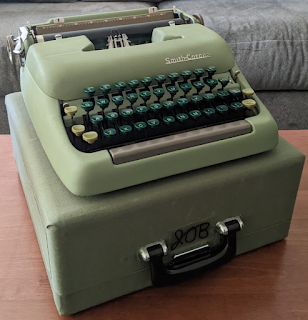Praxis of Fixing a Praxis - Part 1
If I had a nickel for every electric desktop machine that I have bought that doesn't work practically at all, I would have 3 nickels. If you include ones that don't fully work as they were designed to, you'd boost that total up to 5 nickels, a whole quarter. I don't have a single desktop electric that still works the way it was meant to like 50 years ago. So much for luck of the Irish, right?
Anyway, I have recently come into possession of an Olivetti-Underwood Praxis 48, constructed in Olivetti's home factory in Ivrea, and the 3rd in the series of broken desk electrics. I simply couldn't refuse her; she was sitting at the back of the flea market waiting for me, and when I approached, the seller, who, mind you, I have already bought two machines off of, immediately said that is was only $5. Five United States dollars. There was no way I could refuse that offer, even if the machine was totally unsalvageable. The modernist design of this machine alone made it worth buying; an elegant yet utilitarian box with a keyboard jutting out of it, there's no wonder why they have one of these things in the San Francisco Museum of Modern Art! I'm not much for descriptions, so I will let the pictures speak for themselves.
My efforts at revitalizing this machine began once I had brought it home. I lugged it in the house, Italian steel isn't light, folks, and began to wonder, no, pray that this thing would work. "How lovely would it be to have such an iconic machine in working order," I must have thought. Then I turned it on its back and out fell a handful of birdseed. Yes, birdseed. I'm guessing that this thing was kept not in the attic or the basement, but in the shed, where someone, perhaps decades ago, spilled birdseed into this wonderful machine. I plugged it in to test it out, naively thinking that maybe some seeds were just a funny little aside in the triumphant story of my first Olivetti, but no, it was only the beginning of a tragic comedy.
I flipped the on switch and the beast chugged to life, a better start than some of my other machines, but it didn't get very far afterward. No keys would strike, the carriage could barely return, and the only function that worked was the space, single and repeat both firing away as though nothing else was amiss. I was a little disheartened, but I wasn't overly invested yet, only $5 and 10 minutes of time had been sunk into this thing so far and I am no quitter, at least not that early on. I set the machine aside, as aside as it would go on my limited desk space, and went back to school for the week, a little bummed about the whole thing, but also excited about the other machine that I got at the flea market that day, which I'll likely make a post about in the near future, if I haven't already. No idea when I'll be posting this, I don't even know if I have pictures of the machine all cleaned up.
Anyway, fast-forward to a week to the next weekend where I was finally able to work on the mean, green writing machine that I had since named Semera, a bastardized feminization of the word seme, the Italian word for seed. I was going to go with Latin, but naming a machine Semen is not my vibe. I began the cleaning process by giving the exterior of the machine a good cleaning with some Simple Green, though I fell like it could use a better scrubbing, especially on the keyboard, as the job I did was rather quick and half-assed. The machine looks much nicer now, though, trust me. After a good, but not very good, wiping down, I took the monster outside and tried to take the big silver main body cover. Emphasis on tried, as I couldn't get it to budge past a a certain point and, fearing I would mar this machine's cosmetic beauty, I dared go no further. I was able to remove the bottom plate of the machine, literally the twist of one screw and the popping out of a sheet of metal, which exposed the guts of the beast. Nothing seemed to be missing mechanically, though what the hell do I know, so I proceeded with a routine cleaning; dripping some mineral spirits over the usual problem areas (the main hinges in the type basket, the connective linkages below the typebars, the margin and tab setters, and the ribbon selector) and blew them out with my dad's 30 year old air compressor. Something must have worked a little, as I finally got the typebars to move a little bit when keys were struck, though it was a rather pathetic little hop accompanied by the bounding of the ribbon vibrator, though the keyboard would then seize up after each hop and I would have to press the backspace to disengage them again. My fiddling also seemed to upset the ribbon selector, as it now won't select for black. Physically; the switch and its corresponding linkages within won't go past the stencil to black, meaning it can only print in red. It isn't to big a deal though, seeing as it DOESN'T TYPE AT ALL! Very frustrating, I tell you.
That is where I left off with the machine, and I won't be able to touch it for another 5 days, which is probably good for my health and the health of my machine, as I'm sure I'd toss it across the yard if I stuck my hands in there right now. I think that is all for this chapter in my prattling Praxis tale, until, next time,
Jake



Comments
Post a Comment